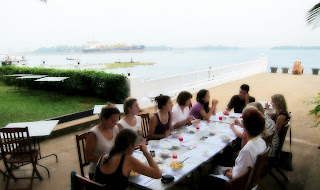A teaspoon a day, boosts your health in many ways.
Cinnamon's unique healing abilities come from three basic types of components in the essential oils found in its bark. These oils contain active components called cinnamaldehyde, cinnamyl acetate, and cinnamyl alcohol, plus a wide range of other volatile substances.
Anti-Clotting & Anti-Inflammatory Actions
The cinnaldehyde in cinnamon helps prevent unwanted clumping of blood platelets. (The way it accomplishes this health-protective act is by inhibiting the release of an inflammatory fatty acid called arachidonic acid from platelet membranes and reducing the formation of an inflammatory messaging molecule called thromboxane A2). Cinnamon's ability to lower the release of arachidonic acid from cell membranes also puts it in the category of an “anti-inflammatory” food that can be helpful in lessening inflammation.
Anti-Microbial Activity
Cinnamon’s essential oils also qualify it as an “anti-microbial” food, and cinnamon has been studied for its ability to help stop the growth of bacteria as well as fungi, including the commonly problematic yeast Candida. Cinnamon’s antimicrobial properties are so effective that recent research demonstrates this spice can be used as an alternative to traditional food preservatives.
Blood Sugar Control
Cinnamon may significantly help people with type 2 diabetes improve their ability to respond to insulin, thus normalizing their blood sugar levels. Compounds in cinnamon not only stimulate insulin receptors, but also inhibit an enzyme that inactivates them, thus significantly increasing cells’ ability to use glucose.
Calcium and Fibre Improve Colon Health and Protect Against Heart Disease
In addition to its unique essential oils, cinnamon is an excellent source of the trace mineral manganese and a very good source of dietary fibre, iron and calcium. The combination of calcium and fibre in cinnamon is important and can be helpful for the prevention of several different conditions. Both calcium and fibre can bind to bile salts and help remove them from the body. By removing bile, fibre helps to prevent the damage that certain bile salts can cause to colon cells, thereby reducing the risk of colon cancer. In addition, when bile is removed by fibre, the body must break down cholesterol in order to make new bile. This process can help to lower high cholesterol levels, which can be helpful in preventing atherosclerosis and heart disease. For sufferers of irritable bowel syndrome, the fibre in cinnamon may also provide relief from constipation or diarrhoea.
Cinnamon's unique healing abilities come from three basic types of components in the essential oils found in its bark. These oils contain active components called cinnamaldehyde, cinnamyl acetate, and cinnamyl alcohol, plus a wide range of other volatile substances.
Anti-Clotting & Anti-Inflammatory Actions
The cinnaldehyde in cinnamon helps prevent unwanted clumping of blood platelets. (The way it accomplishes this health-protective act is by inhibiting the release of an inflammatory fatty acid called arachidonic acid from platelet membranes and reducing the formation of an inflammatory messaging molecule called thromboxane A2). Cinnamon's ability to lower the release of arachidonic acid from cell membranes also puts it in the category of an “anti-inflammatory” food that can be helpful in lessening inflammation.
Anti-Microbial Activity
Cinnamon’s essential oils also qualify it as an “anti-microbial” food, and cinnamon has been studied for its ability to help stop the growth of bacteria as well as fungi, including the commonly problematic yeast Candida. Cinnamon’s antimicrobial properties are so effective that recent research demonstrates this spice can be used as an alternative to traditional food preservatives.
Blood Sugar Control
Cinnamon may significantly help people with type 2 diabetes improve their ability to respond to insulin, thus normalizing their blood sugar levels. Compounds in cinnamon not only stimulate insulin receptors, but also inhibit an enzyme that inactivates them, thus significantly increasing cells’ ability to use glucose.
Calcium and Fibre Improve Colon Health and Protect Against Heart Disease
In addition to its unique essential oils, cinnamon is an excellent source of the trace mineral manganese and a very good source of dietary fibre, iron and calcium. The combination of calcium and fibre in cinnamon is important and can be helpful for the prevention of several different conditions. Both calcium and fibre can bind to bile salts and help remove them from the body. By removing bile, fibre helps to prevent the damage that certain bile salts can cause to colon cells, thereby reducing the risk of colon cancer. In addition, when bile is removed by fibre, the body must break down cholesterol in order to make new bile. This process can help to lower high cholesterol levels, which can be helpful in preventing atherosclerosis and heart disease. For sufferers of irritable bowel syndrome, the fibre in cinnamon may also provide relief from constipation or diarrhoea.




